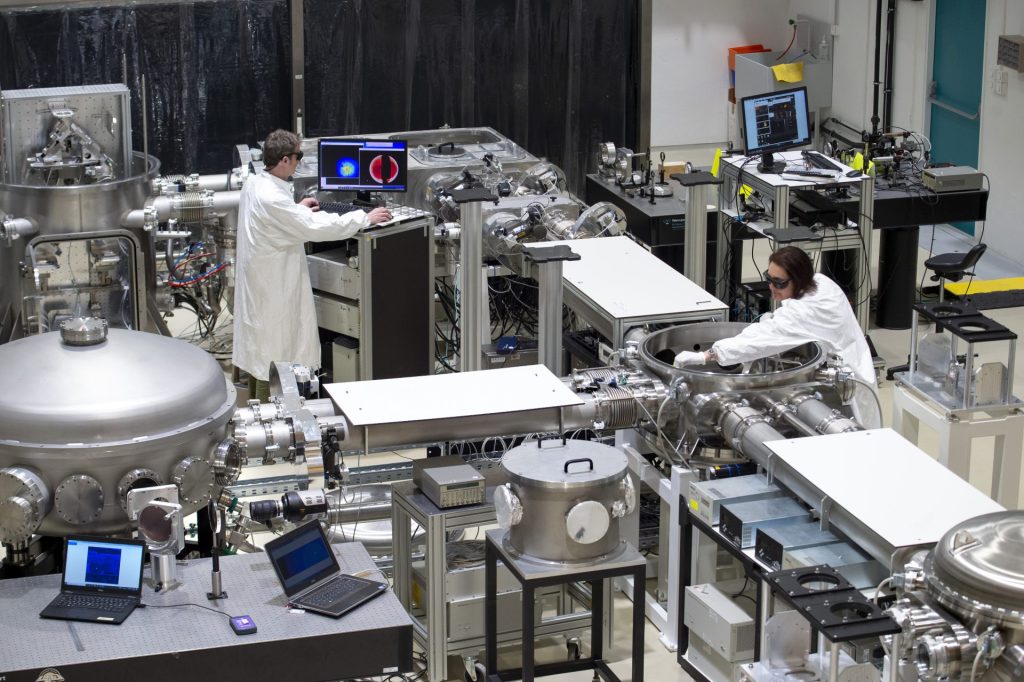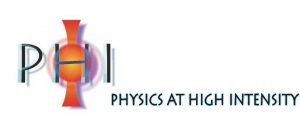Présentation du groupe PHI

Les technologies laser de puissance n’ont cessé de progresser depuis la découverte de la technique d’amplification à dérive de fréquence – permettant de produire des impulsions ultra courtes (fs) -, jusqu’aujourd’hui où l’augmentation des énergies laser accessibles permet d’exposer la matière à des intensités maximales de l’ordre de 1023W/cm2.
Le groupe PHI étudie les phénomènes physiques qui interviennent lors du couplage du laser avec la matière, solide ou gazeuse, en régime relativiste, c’est-à-dire pour des éclairements supérieurs à un éclairement seuil au-delà duquel les électrons atteignent une énergie cinétique supérieure à leur énergie au repos.
Ainsi au delà de 1018 W/cm2, la matière devient plasma et des particules chargées (électrons/ions) peuvent être propulsées à des vitesses relativistes en quelques attosecondes. La physique associée à ces nouveaux régimes, appelée physique des Ultra-Hautes Intensités (UHI), est ultra-relativiste, fortement non-linéaire et hors-équilibre, ce qui rend son étude particulièrement importante d’un point de vue fondamental.
Depuis environ 15 ans maintenant, nous avons construit notre expertise autour de deux axes. Le premier porte sur l’étude de composants optiques remarquables appelés miroirs plasmas. Ces composants sont aujourd’hui employés aussi bien pour augmenter le contraste temporel des impulsions lasers intenses que pour produire de manière synchronisée des sources de particules relativistes (électrons/ions) et des sources harmoniques XUV très intenses de durée attoseconde.
Parmi les pistes de travail explorées par le groupe, on note en priorité l’utilisation de tels dispositifs pour booster l’intensité laser sur cible, et le développement de sources de particules de bonne qualité via un concept innovant de couplage de ces miroirs avec des cibles gazeuses.
Le second axe porte sur le développement d’accélérateurs compacts d’électrons obtenus en focalisant un laser de puissance dans un jet de gaz,
ce qu’on appelle communément l’accélération laser-plasma. Ce type de sources a gagné en maturité au fil des années et la physique du couplage entre le laser et le plasma sous dense est maintenant bien connue. Les enjeux à venir sont : 1) de vérifier les lois d’échelles sur les nouveaux lasers PW qui sont progressivement opérationnels dans le paysage international et aller vers les hautes énergies d’une part et 2) de construire des machines fiables et orientées vers les applications (fondamentales ou sociétales).
Les études expérimentales sont réalisées sur notre plateforme expérimentale UHI100 en grande partie et sur d’autres systèmes de classe 100TW et plus via de multiples collaborations avec des laboratoires du Plateau de Saclay (LOA, LPGP, LULI, LLR, IJCLab, ISMO) aussi bien qu’européens (CNR_ Pise, LLC Lund, HZDR Dresden…) ou encore internationaux (BELLA, …).
Les sujets de recherche du groupe font également appels à des simulations numériques réalisées sur les plus gros calculateurs mondiaux (Frontier, Summit, Lumi…) ainsi que sur les machines de calculs disponibles en France, ceci via des collaborations et/ou des allocations de temps de calculs obtenus suite au dépôt de projets.
Sandrine DOBOSZ DUFRENOY
Cheffe du groupe PHI



